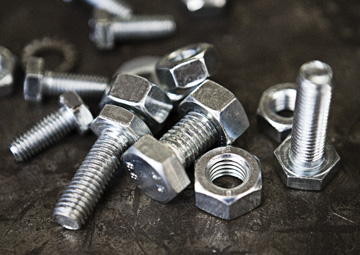What happens when fasteners become loose and how to prevent it?
Fasteners self-loosening is the result of a combination of causes. Materials relaxation and embedding reduce the preload in bolted joints, in turn allowing vibration to initiate repeated transverse movement in the joint. Fasteners will come loose and fail, leading to equipment failures and dramatic accidents.
Engineers must specify at the design stage fasteners that will preserve enough preload throughout the lifetime of the joint. The Junker vibration test has become the standard for testing the security of fasteners and assem- blies in real service conditions and compare their resistance to vibration. A modern fastener vibration and torque test bench can provide a detailed dynamic analysis of all aspects of fastener performance.
Threat 1: Transverse movement
Bolted joints rely on preload from tightening torque. However, if a transverse force acting on the joint is greater than the frictional resistance of the preload, relative motion occurs between the mating threads and the fastener bearing surface. Repeat- ed transverse movements can completely loosen fasteners.
Where does the tightening torque go?
To fasten a bolt, a tightening torque (M_{A}) is necessary. This tightening torque (M_{A}) is the combination of the torques related to the friction under the head (M_{K}), to the friction in the threads (M_{G}) and to the thread pitch(M_{TP}): M_{A} = M_{K} + M_{G} + M_{TP}
In many cases, only about 10% of the tightening torque leads to joint preload (M_{TP}). If friction under the
head M_{K} or friction in the threads M_{G} are increased by only 5%, this can lead to a reduction in preload of 50%.
In a bolted joint, the thread pitch torque M_{TP} is less than the combined friction in the thread M_{G} and under the head M_{K}. This is called self-locking. The tensile force generated by the elongation of the bolt shaft and by the force of compression generated in the objects being tightened remain balanced: M_{TP} < M_{K} + M_{G}
So why do bolted joints loosen?
In practice, most bolted joints experience influence from the surrounding environment. This can lead to a change in the balance and spontaneous decrease in the preload.
To loosen a bolted joint, the moment M_{L} is necessary: M_{L}=M_{K}+M_{G}-M_{MTP}
The pitch torque M_{TP} works to unfasten the bolt. This is because of the helix angle of the thread pitch. So, when the internal off torque is larger than the retention moments M_{K}+M_{G}, rotational self-loosening will take place: M_{TP} > M_{K} + M_{G}
Rotational self-loosening
The transverse movement required to overcome the frictional resisting force, also called ‘theoretical limiting displacement’ (SGth) or ‘marginal slip’ can be calculated:
SG_{th} = \frac { F_V * \mu_K * L_k^3 } { 12 * E * I}Where SG_{th}: theoretical limiting displacement; F_V: the preload in the bolt; \mu_K: friction under the head of the bolt; L_K: clamping length of the bolt; E: Young’s modulus of the bolt; I: second moment of area of the bolt.
Threat 2: Loosening without rotation
Rotational self-loosening is only one threat. Components deformation can also cause loss of preload.
Relaxation is where components are effectively stretched or deformed beyond yield point by the loads applied to them.
Embedding results from local deformation under the nut and bolt face, in the joint faces and in the threads. This can occur even when the loading is below the apparent yield points. It is the result of surface matting in the area of contact between surfaces.
In practice, the loosening of nuts and bolts is often the result of a combination of causes. Relaxation leads to a preload reduction, in turn allowing joint movement to occur, resulting in self-loosening.
Creating secure fastenings
The fastening will not come loose if the clamping force (“preload”) acting on the bolts creates sufficient friction grip to prevent transverse movement between the clamped parts.
This must be ensured at the design stage by selecting a fastener size, strength class, and surface properties able to maintain enough preload and friction grip to overcome external loads throughout the lifetime of the joint.
Your safeguard: testing
Testing fasteners in real service conditions is the only practical way to establish safe fastener specifications.
The Junker vibration test has become the standard for testing the security of bolted joints and compare their self-loosening behaviour.
The test machine applies a cyclic transverse displacement to a bolted joint, while the bolt preload is monitored continuously.
A modern Junker test bench can assess transverse displacement and the marginal slip, and determine the relation between applied torque and tension to provide detailed dynamic analysis of all aspects of fastener performance.
All the performance parameters involved in the loss of tightening torque, and the loss of preload outlined above can be accurately assessed. Data can be shown as a graphic display, and all variables required to deliver precisely accurate and fully reproducible tests are available. The actual performance of any proposed fastening can be predicted – and the selection of an appropriate specification for any particular application ensured.
This versatility allows the Junker test bench to provide a simply-expressed and highly accurate measure of performance in the real world, and perform statutory ISO and DIN testing.
Tips from the experts
Tables exist which may indicate which fastening specification is adequate for a particular application. However, in the real world, there are many additional factors such as material, plating, surface finish, thread lubricants, corrosion and wear to consider. Testing is essential to ensure a fastening is adequate for actual service conditions.
We highly recommend studying these resources:
1. Junker G, New Criteria for Self-Loosening of Fasteners Under Vibration, Transactions of the Society of Automotive Engineers, Vol. 78, 1969, pp. 314-335, New York
3. DIN 25201-4:2010-03 Annex B. Test specification for demonstrating the resistance to self-loosening of secured bolted joints, Deutsches Institut für Normung c.V., Berlin 2010
4. ISO 16130:2015 Dynamic testing of the locking behaviour of bolted connections under transverse loading conditions (vibration test), International Organisation for Standardization, Geneva 2015


